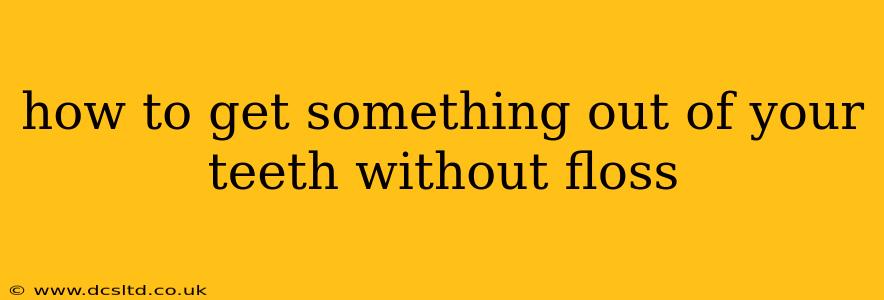Getting something stuck between your teeth is a frustratingly common experience. While floss is the ideal tool for this situation, there are times when it's not readily available. This guide offers several alternative methods to dislodge that pesky food particle or other debris, helping you regain a comfortable and clean smile.
What to Do if You Don't Have Floss
Before we explore alternatives, it's crucial to emphasize that floss remains the best option for thorough interdental cleaning. These alternatives are helpful in a pinch, but regular flossing is essential for maintaining good oral hygiene.
Here are some methods you can try when floss is unavailable:
1. Using a Toothpick
A toothpick can be surprisingly effective for removing larger pieces of food. Gently insert the pointed end into the space between your teeth, working it carefully to dislodge the obstruction. Avoid excessive force, which could damage your gums or teeth. Remember to discard the toothpick after use.
2. Utilizing a Water Pick (Water Flosser)
If you own a water pick, this is a fantastic alternative to floss. The pulsating stream of water can effectively remove food particles and debris from between your teeth. Adjust the pressure to a comfortable level and direct the stream precisely to the affected area.
3. Employing a Soft-Bristled Toothbrush
A soft-bristled toothbrush can help dislodge smaller particles. Carefully work the bristles into the gap, gently scrubbing back and forth. Be mindful not to apply excessive pressure.
4. Rinsing Thoroughly with Mouthwash
While mouthwash won't physically remove the stuck item, it can help loosen it. Swishing vigorously can dislodge smaller pieces, making them easier to remove with other methods.
5. Using a Tongue Scraper
A tongue scraper can sometimes help dislodge debris from the back of your teeth. While not as precise as floss or a toothpick, the scraping action might loosen the trapped item.
What NOT to Do
Avoid using potentially damaging objects like:
- Metal objects: These can easily scratch or damage your tooth enamel.
- Sharp objects: These pose a significant risk of injury to your gums or soft tissues.
- Excessive force: Gentle pressure is key; forcing an object can cause damage.
Preventing Future Incidents
While occasional food trapping is normal, you can minimize its occurrence by:
- Chewing thoroughly: Break down food into smaller pieces before swallowing.
- Using the correct brushing technique: Proper brushing removes surface debris, reducing the likelihood of food getting stuck.
- Regular flossing: This remains the best way to prevent food from becoming trapped between your teeth.
Frequently Asked Questions
Q: What if I can't get the object out myself?
A: If you're unable to remove the object using these methods, it's best to schedule an appointment with your dentist. They have the tools and expertise to safely remove it and assess any potential damage.
Q: How often should I floss?
A: Dentists generally recommend flossing at least once a day, ideally before bed.
Q: What are the signs of gum damage from improper cleaning?
A: Signs of gum damage can include bleeding gums, redness, swelling, and sensitivity. If you notice any of these symptoms, consult your dentist.
Q: Are there any long-term consequences of not removing food particles from between your teeth?
A: Leaving food particles trapped between your teeth can lead to plaque buildup, gum disease (gingivitis and periodontitis), cavities, and bad breath.
By following these tips and prioritizing good oral hygiene, you can significantly reduce the frequency of food getting stuck between your teeth and maintain a healthy, happy smile. Remember, a quick visit to your dentist is always better than risking potential oral health complications.
